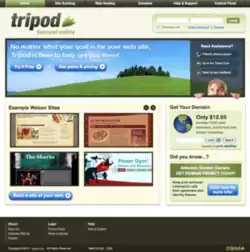 | |
Type of site | web hosting service |
|---|---|
| Owner | Lycos |
| Created by | Bo Peabody, Brett Hershey, and Dick Sabot |
| URL | tripod |
| Commercial | Mixed |
| Registration | Yes |
Tripod.com is a web hosting service owned by Lycos. Originally aiming its services to college students and young adults, it was one of several sites trying to build online communities during the 1990s. As such, Tripod formed part of the first wave of user-generated content. Free webpages are no longer available and have been replaced by paid services.
Services
Tripod offers web hosting with two paid plans, "personal" and "professional", which differ in features and storage space, but are both powered by the web authoring system "Lycos Publish". This tool has completely replaced the former offering of more general web hosting and removed free plans altogether.
Tripod offered free and paid web hosting services, including 20 megabytes of storage space and the ability to run Common Gateway Interface (CGI) scripts in Perl. In addition to basic hosting, Tripod also offered a blogging tool, a photo album manager, and the Trellix site builder for WYSIWYG page editing. Tripod's for-pay services included additional disk space, a shopping cart, domain names, web and POP/IMAP email.
History
Tripod originated in 1992 with two Williams College classmates, Bo Peabody and Brett Hershey, along with Dick Sabot, an economics professor at the school. The company was headquartered in Williamstown, Massachusetts, with Peabody as CEO. Although it would eventually focus on the Internet, Tripod also published a magazine, Tools for Life, that was distributed with textbooks, and offered a discount card for students.[1]
Website launch
The domain name Tripod.com was created on September 29, 1994 and the site officially launched in 1995 after operating in "sneak-preview mode" for a period. Billed as a "hip Web site and pay service for and by college students", it offered how-to advice on practical issues that might concern young people when first living away from home. It planned to charge a minimal fee and make money primarily on commissions from partners who would sell products on the site.[2] Other services available included résumé writing features and a simple home page builder.[1]
Although the feature was an afterthought originally, Tripod soon became known as a place where people could create free web pages, competing with the likes of GeoCities and Angelfire.[3] Criticizing AOL, the existing leader in this space, for its "walled-garden" approach, Peabody described the company's aims: "Our idea is to build a community through user-created and user-based content."[4] A reviewer in The Washington Post recommended Tripod over GeoCities for giving users an easier URL to remember, and because GeoCities sites had a tendency to crash computers.[5]
Investment and buyout
After receiving an initial investment of US$4 million in venture capital, led by New Enterprises Associates, in May 1997 Tripod took an additional round of investment totaling US$10 million. By this time the company had grown to 40 employees and was hoping to reach profitability by the 1st quarter of 1998. The second group of investors included Interpublic, which paid US$2.5 million for a stake in Tripod estimated at 10 percent, thus implying a valuation of US$25 million for the company overall.[1] On February 3, 1998, Lycos announced they had acquired Tripod for a reported US$58 million in stock.[6][7]
Lycos also ended up owning Tripod's former competitor Angelfire, picked up as part of the acquisition of WhoWhere. The two properties were run concurrently, with Tripod continuing to focus on its college-age audience while Angelfire tended to attract high school users. In early 2001, Tripod reached six million registered users (up from nearly one million at the time it was acquired) and was expanding at an estimated 250,000 new sites per month. However, generating profits remained difficult, with an analyst opining that they needed better user profiling so the sites could generate the results expected by advertisers. They also had the challenge of not alienating users while trying to make money.[8] By the end of the year, Tripod and Angelfire also introduced account options allowing users to pay in order to keep their sites ad-free. GeoCities, now acquired by Yahoo!, would follow suit not long afterward.[9]
In 2009, Tripod removed the option to use its services for free. After this, users were required to pay for it.[10]
Domain name
Web sites generally are a subdomain of tripod.com. However, users can pay a monthly charge and own a domain name. Paying in this manner also allows for other benefits, such as more disk space for the site which allows the site owner to put more information onto it, and personalized email accounts.
References
- 1 2 3 Elliott, Stuart. "Interpublic invests in an Internet provider aimed at 'the transition generation' of young adults". The New York Times, May 28, 1997, p. D5.
- ↑ Shannon, Victoria. "Board Bulletin". The Washington Post, May 31, 1995, p. R22.
- ↑ Akst, Daniel. "So You're Ready for a Web Page". Los Angeles Times, June 24, 1996, p. 3.
- ↑ Sreenivasan, Sreenath. "New Neighborhood, No Money Down". The New York Times, March 17, 1997, p. D5.
- ↑ Hertzman, Monica Neal. "It didn't take a miracle to share their trip. Just the Web". The Washington Post, July 11, 1999, p. E1.
- ↑ Technology Brief. "Lycos Inc.: Acquisition of Tripod Inc. Expected to Be Announced". The Wall Street Journal, February 3, 1998, p. 1.
- ↑ "Lycos Buys Tripod for $58 Million". Bloomberg News. 1998-02-03. Retrieved 2021-12-01 – via The New York Times.
- ↑ Musgrove, Mike. "A Home Page of One's Own: Free, Easy Site-Hosting Services Tap Into the Urge to Post". The Washington Post, January 28, 2001, p. H1.
- ↑ Walker, Leslie. "Many 'Free' Home-Page Sites Putting the Squeeze on Users". The Washington Post, March 10, 2002, p. H7.
- ↑ "Tripod Free Hosting Closes Down". T35 Hosting. 17 January 2012.